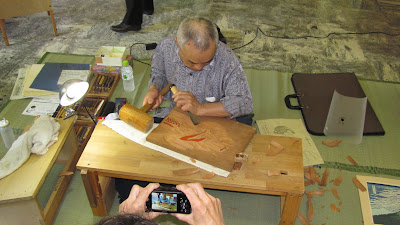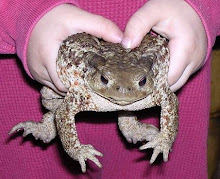Here are a few more things I wanted to share from early June's International Moku Hanga Conference in Kyoto/Awaji Island. I'm an amateur printmaker and my interests were particularly focused on the practical aspects of carving and printing rather that the historical or cultural impact of Ukiyo-e prints. (although I greedily looked at as much as I could for ideas to incorporate, expand upon, borrow or appropriate.)
In the first day's demonstrations of Kyoto-style printing and traditional carving, I went over to watch traditional Ukiyo-e carver, Mr. Hiroshi Fujisawa carving a cherry block. I didn't take photos of the first part as I was watching too closely--he carved the outline of these shapes using a hangi-toh chisel--a pointed chisel to incise precisely against the edge of the shape using two to three cuts. These would serve as stop-cuts to be cleanly edged away using an Aisuke or bull-nosed chisel to cleanly pare away the wood up to the incised edge.
But before that he had to clear away all the waste wood, that which would not print.
Here in these four photos he is using a mallet and curved chisel to rapidly clear almost up against he already incised shapes.
I was quite taken by how quick he was and how close to the carved shapes he was clearing--I haven't the control to work that close so it takes me a lot longer.
Finally using a much wider, shallower chisel he finished clearing the areas around the printing surface.
He cleared the blocks much the way I would use an eraser to clean off a blackboard.
Tap, Tap, Tap large chips of wood were flying.
He has carved peg holes in his low work bench and there is a bench dog(that square peg) the board is butted against to keep it from sliding away.
he did in about an hour what would take me at least a day.
Later that week on Awaji Island, Mr. Shoichi Kitamura(carving) and Mr. Makoto Nakayama (printing) led a panel discussion and presentation of "Mokuhanga in Japan Today--Collaborations between Craftsmen and Artists" detailing and providing examples of their work done in collaboration with Artists from the UK and Australia.
Here was one very striking and stunning example of what's possible:
This photo shows four watercolor paintings/drawings by the UK artist Rebecca Salter;
On the left are her original paintings that were used by the studio to prepare blocks and print from.
On the Right are the woodblock prints.
The drawings by themselves werea already very special but it was the reworking of them as woodblock prints using ukiyo-e traditional methods and the amazing richness and depth of color and surface that was quite remarkable for me as a "striving-to-improve" neophyte woodblock artist.
There were obviously subtle differences-they were not identical but they were gorgeous and it was quite eye-opening for me to see the reproduction of splotchy ink drops and bleeding/seeping ink marks reproduced using multiple blocks and over printings. They talked about the range of techniques that could be used; printing on the back to have the color bleed through, careful multiple bokashi-printings, etc.etc. One not-so-obvious revelation was the careful division of the block to be printed into sections and small areas of bokashi might be printed section by section rather than trying to accomplish it all at once.
Here below is one process photo during the carving of one of the blocks and the carver holding a piece of dried equisitum (Horsetail plant) which has a raspy/sandpaper like surface used to sand down the edges of the shapes to allow for softer printing.(that's NOT a cigarette in his mouth but a small piece of dried horsetail being moistened).
They spoke a bit about how challenging this project had been for them but how they enjoyed the challenge and welcomed future work and collaboration with fine artists to realize works using traditional moku hanga techniques.
All I know is I can't wait to try printing an ink blotch--on purpose. ( I get quite a few by accident...).
Subscribe to:
Post Comments (Atom)








great to see these again!
ReplyDelete